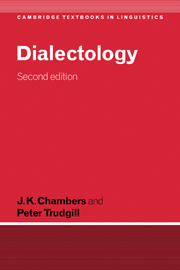7 - Boundaries
Published online by Cambridge University Press: 05 June 2012
Summary
Traditional dialectology focused attention on regional differences in speech, and out of that came the construct known as ISOGLOSSES, the lines marking the boundaries between two regions which differ with respect to some linguistic feature (for instance, a lexical item, or the pronunciation of a particular word). In this chapter we will take a closer look at some isoglosses in order to determine their function and their usefulness in dialectology.
Isoglosses
The term ‘isogloss’ was first used by J. G. A. Bielenstein, a Latvian dialectologist, in 1892. He apparently modelled his new word on the meteorological term isotherm, a line drawn between two locations with the same average temperature. Isogloss literally means ‘equal language’ (Greek iso+gloss). Presumably, the word is intended to convey the fact that a line drawn across a region will show two areas on either side which share some aspect of linguistic usage but which disagree with each other.
Dialectologists have used the term in two slightly different ways, with the result that the isogloss has been represented graphically in two different ways. Although it is always possible to transliterate one representation into the other, someone who is not aware of both is likely to be confused upon first encountering the unfamiliar one.
- Type
- Chapter
- Information
- Dialectology , pp. 89 - 103Publisher: Cambridge University PressPrint publication year: 1998



